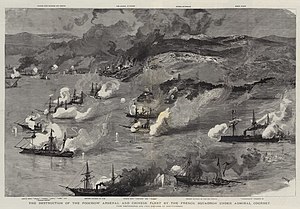Battle of Foochow
| Battle of Fuzhou Combat naval de Fou-Tchéou 馬江海戰 |
|||||||
|---|---|---|---|---|---|---|---|
| Part of the Sino-French War | |||||||
 The Battle of Fuzhou, 23 August 1884 (19th century painting) |
|||||||
|
|||||||
| Belligerents | |||||||
|
|
|
||||||
| Commanders and leaders | |||||||
|
|
|
||||||
| Units involved | |||||||
| Fujian Fleet | Far East Squadron | ||||||
| Strength | |||||||
| 22 ships (11 Western-style ships, the rest Chinese Junks) | 13 ships | ||||||
| Casualties and losses | |||||||
| 796 dead 150 wounded 51 missing 9 ships sunk 10+ ships damaged |
10 dead 48 wounded 2 ships damaged |
||||||
| French casualties include all casualties from 23 to 31 August 1884 (i.e. both at Fuzhou and during the descent of the Min River) The total number of Chinese casualties stands at 2,000 or 3,000 for the entire conflict (i.e. including the descent of the Min River) |
|||||||
The Battle of Fuzhou, or Battle of Foochow, also known as the Battle of the Pagoda Anchorage (French: Combat naval de Fou-Tchéou, Chinese: , 馬江之役 or 馬尾海戰, literally Battle of Mawei), was the opening engagement of the 16-month Sino-French War (December 1883 – April 1885). The battle was fought on 23 August 1884 off the Pagoda Anchorage in Mawei (馬尾) harbour, 15 kilometres to the southeast of the city of Fuzhou (Foochow). During the battle Admiral Amédée Courbet's Far East Squadron virtually destroyed the Fujian Fleet, one of China's four regional fleets.
On 11 May 1884 French and Chinese negotiators concluded the Tientsin Accord, an agreement designed to end several months of undeclared hostilities between France and China in Tonkin. On 23 June 1884, French troops advancing to occupy Lang Son, in accordance with the terms of this agreement, clashed near the small town of Bac Le with a detachment of the Chinese Guangxi Army. The Chinese opened fire on the advancing French, precipitating a two-day battle in which the French column was seriously mauled. This incident, the Bac Le Ambush, was the proximate cause of the Sino-French War.
When news of the Bac Le Ambush reached Paris, there was fury at what was perceived as blatant Chinese treachery. Jules Ferry’s government demanded an apology, an indemnity, and the immediate implementation of the terms of the Tianjin Accord. The Chinese government agreed to negotiate, but refused to apologise or pay an indemnity. The mood in France was against compromise, and although negotiations continued throughout July, Admiral Courbet was ordered to take his squadron to Fuzhou (Foochow).
Courbet was instructed to prepare to destroy the Foochow Navy Yard, fifteen kilometres downriver from Fuzhou at Mawei, and to attack the Chinese fleet in Mawei harbour. Ironically, the Foochow Navy Yard represented a substantial French investment in China's future, having been built several years earlier under the direction of the French administrator Prosper Giquel. During the second half of July and the first half of August Courbet gradually concentrated his squadron in Mawei harbour, at the Pagoda Anchorage—named for a conspicuous Chinese pagoda, the Luoxingta (羅星塔), which stood on a hill above the harbour.
...
Wikipedia
